Shoulder Arthritis — Shoulder Joint Replacement: treatment in the Best Hospitals in the World
Treatment prices are regulated by national law of the corresponding countries, but can also include additional hospital coefficients. In order to receive the individual cost calculation, please send us the request and medical records.
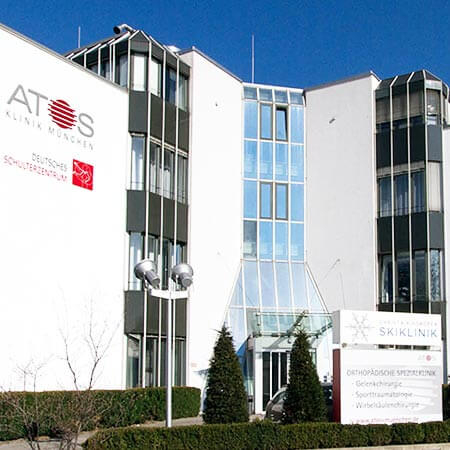
Department of Orthopedics, Foot Surgery, Hand Surgery and Spinal Surgery
According to the prestigious medical magazine Focus, the Department of Orthopedics, Foot Surgery, Hand Surgery and Spinal Surgery is one of the best medical facilities in Germany, specializing in shoulder and knee surgery, foot surgery, and hand surgery! The department offers a full range of medical services for diseases of the musculoskeletal system. The key focus of the department's doctors is the treatment of diseases of the large joints: knee, hip, shoulder, elbow, ankle, and wrist. Foot surgery specialists are responsible for the correction of hallux valgus, hallux rigidus, clubfoot, flatfoot, and claw toes, as well as the treatment of ankle arthrosis, heel spurs, and Achilles tendon ruptures. The department regularly admits patients with hand diseases, with particular interest in the treatment of wrist arthrosis, rhizarthrosis, carpal tunnel syndrome, and Dupuytren's contracture. The therapeutic offer is complemented by conservative and surgical treatment of spinal diseases such as herniated discs, spinal canal stenosis, vertebral fractures, and others. The department's medical team offers patients effective conservative treatment methods. However, when surgery is required, arthroscopic and minimally invasive techniques are preferred to ensure the fastest possible postoperative recovery and a high level of safety.
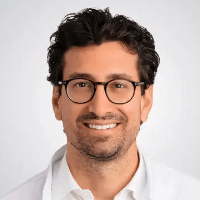

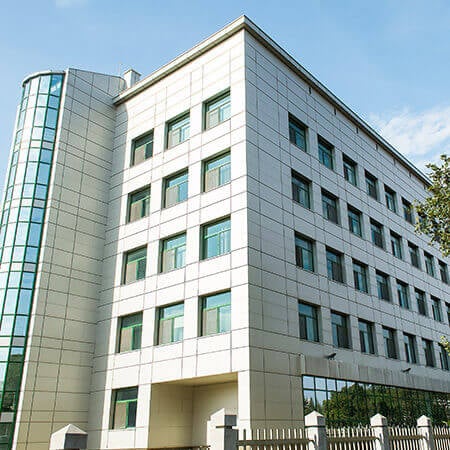
Department of Adult and Pediatric Orthopedics, Trauma Surgery, Foot Surgery, Hand Surgery and Rheumatology
The Department of Adult and Pediatric Orthopedics, Trauma Surgery, Foot Surgery, Hand Surgery and Rheumatology offers the full range of diagnostic and therapeutic services in its areas of specialization. The key areas of work of the department's doctors include large joint arthroplasty, arthroscopic interventions on the knee, hip, and shoulder joints, conservative and surgical treatment of foot and hand diseases and deformities, rheumatic joint lesions, orthopedic diseases in children, and musculoskeletal injuries. The key to successful clinical practice is the professionalism and unique experience of the department's medical team, combined with the advanced infrastructure and state-of-the-art equipment. The department has 5 operating rooms equipped with the latest technology. Most surgical interventions are performed using minimally invasive techniques, due to which, in the shortest possible time, the patient is verticalized, their mobility is restored, and a pronounced pain syndrome is excluded. The department annually performs more than 4,500 surgical interventions, including especially complex ones, so the specialists at the medical facility are rightfully proud of their impressive clinical experience in the surgical treatment of orthopedic diseases. Over the years, the department has gained an excellent reputation not only in Germany but also far beyond its borders.
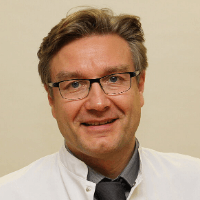



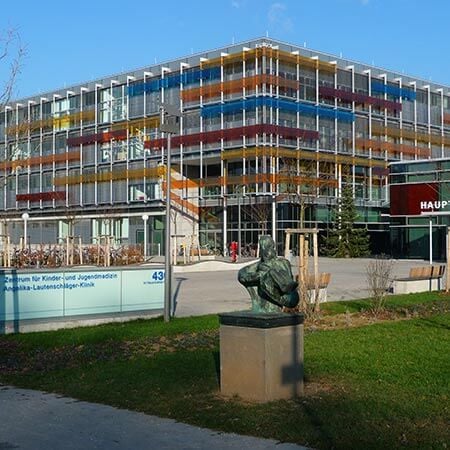
Department of Adult and Pediatric Orthopedics, Traumatology
According to Focus magazine, the University Hospital Heidelberg ranks among the top five hospitals in Germany! The hospital is one of the most advanced and reputable medical institutions not only in Germany, but throughout Europe. There are more than 43 specialized departments and 13 medical institutes, which cover all fields of modern medicine. A distinctive feature of the hospital is the presence of unique therapeutic methods for the treatment of complex and rare clinical cases.






Shoulder injuries, hard physical work, previous inflammatory diseases – all this can lead to the development of shoulder arthrosis. The disease causes cartilage and bone structure lesions, constant shoulder pain, decreased range of motion, or the development of joint instability. Such situations require shoulder replacement surgery.
You can undergo treatment abroad. Doctors in developed countries perform effective surgery that completely eliminates pain and restores limb function. Modern artificial joints wear out very slowly, even in young and physically active patients. After surgery and rehabilitation, you can not only lead an active life, but also play sports or do physical labor.
Please use the services of Booking Health to undergo medical treatment abroad. On our website, you can see the cost of treatment and compare prices in order to book a medical care program at an affordable price.
Content
- Who may need shoulder replacement?
- When may the patient with arthrosis need shoulder replacement surgery?
- What are the success rates of joint replacement surgery?
- What types of joint replacement surgery can be performed?
- When is shoulder hemiarthroplasty performed?
- When can total shoulder replacement be performed?
- Joint replacement surgery for post-traumatic arthrosis?
- Why is it worth undergoing medical treatment abroad?
- Treatment in European hospitals with Booking Health
Who may need shoulder replacement?
Arthrosis is the most common indication for replacement surgery of most large joints. Shoulder replacement surgery can also be performed for this disease. However, this indication is not considered the main one. The interventions are more often performed for such severe injuries as bone fractures and dislocations, if the problem cannot be solved with the help of other surgical procedures. Replacement surgery can also be used for rheumatoid arthritis and other rheumatic diseases, shoulder tumors, and irreparable rotator cuff tendon tears.
Tens of thousands of shoulder replacement procedures are performed every year in Europe. While replacement surgery for other large joints is mainly used in elderly patients, the shoulder is more often replaced for young people. Frequently, replacement surgery can be performed at the age of 20-30. Approximately two thirds of all operations are performed for patients under the age of 60, that is, patients of working age.
Given the age of the patients, it is very important that surgery gives good long-term outcomes. The prosthesis should last as long as possible, fully restore the function of the upper limb and give the opportunity to lead an active lifestyle, do physical labor.
In the early stages of arthrosis, drug therapy is usually used. Doctors achieve good results with the help of regenerative therapy: injection of stem cells and platelet-rich plasma into the joint. If this treatment does not work, they opt for surgery. It is performed arthroscopically. Doctors remove freely located cartilaginous bodies inside the joint, osteochondral outgrowths and resect the synovial membrane of the shoulder joint. If such treatment is ineffective, shoulder replacement surgery will be performed.
Shoulder joint replacement is a surgery that includes substitution of the severely diseased joint with a prosthesis.
Cost of arthroplasty in shoulder arthritis starts from €11,887. You can find other treatment prices on the Booking Health website.
The best hospitals in Europe are:
- University Hospital Rechts der Isar Munich
- Vitos Orthopedic Clinic Kassel
- ATOS Clinic Munich
- University Hospital Frankfurt-am-Main
- University Hospital of Ludwig Maximilian University of Munich
When may the patient with arthrosis need shoulder replacement surgery?
If arthrosis of the lower extremities is common, shoulder joint is affected much less often. The upper limbs do not support body weight. Accordingly, they do not wear out with age, as they do with the knee or hip joint.
If shoulder arthrosis develops, it is usually secondary, that is, it has a very specific cause. Less common are cases of primary or idiopathic (unknown origin) osteoarthritis.
Types of shoulder arthrosis according to its origin:
- Idiopathic – involutive (age-related degeneration) or microtraumatic (the result of repeated microtraumas).
- Post-traumatic – a degenerative process develops after suffering a significant one-time injury, and may be the result of poor quality of treatment.
- Post-infectious arthrosis-arthritis (develops after an infectious joint inflammation).
- Shoulder arthrosis due to systemic diseases (often other joints are also affected at the same time).
- Dystrophy of the head of the bone due to its instability (as a rule, a consequence of the habitual shoulder dislocation).
Joint replacement surgery for arthritis is the last-line treatment. It is used if conservative therapy is ineffective. The procedure is performed with persistent pain, impaired limb mobility, in the case of subluxation of the humeral head due to osteochondral growths formed at the posterior edge of the articular surface of the scapula.
What are the success rates of joint replacement surgery?
Shoulder joint replacement surgery usually has good long-term outcomes. Surgical interventions are successful, and implanted endoprostheses wear out very slowly – they last for decades.
For the first time, shoulder replacement surgery was performed back in 1893. It happened in France. The operation was performed on a patient with tuberculous joint destruction, who refused to amputate a limb.
Unfortunately, the first surgeries were unsuccessful. Good results with the restoration of limb function were obtained only in 1950. Already in 1953, replacement surgery of the humeral head was performed with a prosthesis, which is similar to the modern one. In 1974, the second half of the shoulder joint located on the scapula was also replaced for the first time. This surgery was performed for osteoarthritis.
Since then, many types of endoprostheses have been developed. They are reliable, they can fuse well with the bone, completely restore the function of the shoulder and allow getting rid of pain forever. However, the success of treatment depends not only on the operation itself, but also on the subsequent rehabilitation. With high-quality recovery and sufficient patient motivation, the outcomes of even severe forms of osteoarthritis are significantly improved.
What types of joint replacement surgery can be performed?
Joint replacement can be unipolar or total. A unipolar shoulder replacement involves the replacement of only one of its two components. As a rule, it is an artificial humeral head. Total shoulder replacement also involves the implantation of an artificial glenoid cavity of the scapula.
Total shoulder replacement is more common – about 60% of cases. Another 40% of patients undergo unipolar replacement surgery.
Shoulder replacement can be either anatomic or reverse. The anatomic prosthesis actually imitates the patient's own joint, replacing the tissues destroyed by the disease. It is used when the function of the rotator cuff muscles is preserved. Anatomical prostheses are used in 90% of patients.
Reverse replacement surgery is performed in 10% of cases. Such operations are mainly performed for irreparable rotator cuff lesions, rheumatoid arthritis, and for some types of injuries. In this case, the ball-shaped part of the prosthesis is not located on the humerus, as in anatomic replacement surgery, but on the scapular part of the artificial joint.
According to the number of surgical procedures, shoulder replacement can be primary or revision. Revision interventions are performed to replace a worn-out endoprosthesis.
When is shoulder hemiarthroplasty performed?
Whenever possible, doctors use only shoulder hemiarthroplasty. That is, the joint is not totally replaced, but only partially – the humeral head is replaced. The patient retains his own glenoid cavity of the scapula.
The benefits of this approach:
- Less traumatic surgery, which means it is safer for health.
- Faster recovery.
- Slow wear and tear of the prosthesis.
- Lower cost of treatment.
However, shoulder hemiarthroplasty is not always possible. The main indications and necessary conditions for this surgery are:
- The preserved cartilaginous part of the articular surface of the scapula. It must be in good condition to stabilize the shoulder while supporting the artificial humeral head.
- Deficiency of scapular bone tissue, as there may be problems with fixation of the scapular part of the endoprosthesis in the case of total replacement surgery.
- Upward displacement of the humeral head, which usually occurs when the muscles of the shoulder rotator cuff are damaged, less often in case of rheumatoid arthritis.
- Previous shoulder infectious arthritis.
- High load on the shoulder joint. The patient is young, playing sports or doing physical labor. In this case, the wear and tear of the endoprosthesis occurs faster, and after partial replacement surgery, the outcomes last longer.
When can total shoulder replacement be performed?
Total shoulder replacement surgery is performed more frequently. With these operations, the cost of treatment is higher, and the life of the endoprosthesis is shorter. But the functional surgery outcomes are better. If a person does not heavily load the operated arm, the implanted endoprosthesis will be enough for him for the rest of his life.
Total shoulder replacement is the main treatment for severe osteoarthritis. It is effective when not only the shoulder head is damaged, but also the glenoid cavity of the scapula.
The benefits of the intervention, which become especially noticeable long after the surgery:
- Complete absence of pain.
- Full movements in the artificial joint due to the formation of a new center of rotation of the shoulder head.
- Possibility of using it even for severe pathologies, including arthrosis at the advanced stage.
- More muscle strength.
- Higher quality of life.
With a big stress on the operated arm, the polyethylene between the components of the prosthesis quickly wears out. This can lead to bone loss of the scapula and loosening of the endoprosthesis. In this case, a second operation can be performed for its replacement.
Joint replacement surgery for post-traumatic arthrosis?
A severe injury causes a quick joint destruction. The pathological process causes the development of severe arthrosis, which is difficult to treat even with surgery.
The main problems faced by the surgeon are shoulder contractures (stiffness), cicatricial changes in the surrounding soft tissues, gross deformities in the bone structures. First of all, both large and small tubercles are deformed. The tendons of the muscles responsible for shoulder rotation are attached to them. The shoulder nerves are often damaged and neurologic complications develop. The axillary nerve is usually affected, which reduces the strength of the deltoid muscle. The preservation of its strength is the most important condition for successful reverse shoulder joint replacement, which is performed when the muscles of the rotator cuff are affected.
Even in these cases, foreign specialists receive good treatment outcomes. Total replacement surgery helps restore limb function. More than 90% of patients experience complete pain relief. The risk of endoprosthesis loosening within 6 years of medical monitoring is only 10%.
Why is it worth undergoing medical treatment abroad?
The important conditions for both effective and reliable shoulder replacement surgery are state-of-the-art equipment in the hospital, experience and skill of doctors, high-quality endoprostheses. All these things are available in the best hospitals in the world. The treatment in developed countries will permanently relieve pain and restore arm function. After surgery, patients can not only return to an active life, but they are also able to do physical labor or sports. Many surgical procedures are performed for young patients. Despite this, the implanted endoprosthesis will last for a lifetime for most of them.
The benefits of shoulder joint replacement abroad are the following:
- The use of the cutting-edge endoprostheses that ensure the full function of the shoulder joint.
- Complete absence of pain in the late postoperative period in 96% of patients.
- Precise preoperative planning allows doctors to perfectly plan surgery and select the most suitable endoprosthesis model.
- Elimination of the deficiency of the glenoid cavity of the scapula for stable fixation of the components of the artificial joint.
- Successful surgery even after previous unsuccessful interventions, with pseudoparalysis of the shoulder, its instability, post-traumatic bone deficiency of the humerus.
Treatment in European hospitals with Booking Health
Please use the services of Booking Health to undergo treatment in European hospital. On our website, you can find information about the cost of treatment in different hospitals, compare prices and book a medical care program at an affordable price.
Please contact the Booking Health specialists to undergo treatment in European hospital. Here are our benefits for you:
- We will select the best European hospital whose doctors specialize in shoulder replacement surgery.
- We will help you overcome the language barrier, establish communication with your attending physician.
- We will reduce the waiting time for the start of the medical care program and book a doctor's appointment on the most suitable dates.
- We will reduce the price. The cost of treatment in European hospitals will be decreased due to the lack of additional coefficients for foreign patients.
- We will take care of all organizational issues: documents for entering the country, transfer from the airport, hotel, interpreter, etc.
- We will prepare a program and translate medical documents. You do not have to repeat previously performed diagnostic procedures.
- We will provide communication with the European hospital after the completion of the medical care program.
- We organize additional medical examinations and treatment in European hospitals, if necessary.
- We will buy medicines abroad and forward them to your native country.
- We will help you keep in touch with the European hospital and the doctor after the completion of the medical care program.
Booking Health makes treatment in European hospitals easier, faster and cheaper. We will fully organize your trip, and you will only have to focus on restoring your health.
Authors: Dr. Nadezhda Ivanisova, Dr. Sergey Pashchenko

